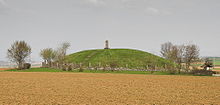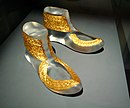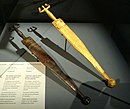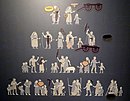Hochdorf Chieftain's Grave


The Hochdorf Chieftain's Grave is a richly-furnished Celtic burial chamber near Hochdorf an der Enz (municipality of Eberdingen) in Baden-Württemberg, Germany, dating from 530 BC in the Hallstatt culture period. It was discovered in 1968 by an amateur archaeologist and excavated from 1978 to 1979 by the State Historical site office known as the Baden Wurttenbberg Landesdenkmalamt under the direction of German archeologist Jorg Biel with association from excavation technician Fritz Maurer.[1] By then, the burial mound covering the grave, originally 6 m (20 ft) in height and about 60 m (200 ft) in diameter, had shrunk to about 1 m (3 ft 3 in) in height and was hardly discernible due to centuries of erosion and agricultural use.

A man, roughly 50 years of age and 180 cm (71 in) tall, was laid out on an exceptionally richly decorated 275 cm (108 in) bronze recliner with eight wheels inside the burial chamber. Judging by other objects found there, this man probably had been a Celtic chieftain: He had been buried with a gold-plated torc on his neck, a bracelet on his right arm, a hat made of birch bark, a gold-plated dagger made of bronze and iron, rich clothing, amber jewelry, a razor knife, a nail clipper, a comb, fishing hooks, arrows, and most notably, thin embossed gold plaques which were on his now-disintegrated shoes. At the foot of the couch was a large cauldron decorated with three lions around the brim, originally imported from Magna Graecia but subsequently altered.[2] This cauldron was originally filled with about 400 L (88 imp gal; 110 US gal) of mead. Hemp or cannabis was also found in the Hochdorf grave.[3][4] The east side of the tomb contained an iron-plated wooden four-wheeled wagon holding a set of bronze dishes—along with the drinking horns found on the walls enough to serve nine people. The whole burial chamber was lined with elaborate textiles.[5]
Krausse (1999) has argued that the material in the Hochdorf burial may denote the combined position of a chief and a priest, or Sakralkönig (sacred king).[6]
According to Gaspani (1998) the diagonals of the rectangular burial chamber were aligned with the major lunar standstill, which occurs every 18.6 years.[7][8]
The Hochdorf grave is located within sight of the Hallstatt-era fortified settlement and 'princely seat' of the Hohenasperg, which is surrounded by other elite burials such as the Grafenbühl grave and the Kleinaspergle.
Following the excavations of the grave the burial mound was reconstructed to its original height. The Keltenmuseum Hochdorf was subsequently built nearby and opened in 1991. During the construction of the museum the foundations of an ancient Celtic village were found, possibly the one to which the chieftain belonged. These were incorporated into the museum.
Gallery
-
 Reconstruction with gold ornaments and dagger
Reconstruction with gold ornaments and dagger -
 Gold artefacts
Gold artefacts -
 Golden shoe ornaments
Golden shoe ornaments -
 Dagger with gold foil
Dagger with gold foil -
 Cauldron and gold bowl
Cauldron and gold bowl -
 Cauldron with drinking horns
Cauldron with drinking horns -
 Gold bowl
Gold bowl -
 Bronze recliner
Bronze recliner -
 Figurine supporting the bronze recliner
Figurine supporting the bronze recliner -
 Funerary wagon reconstruction and display
Funerary wagon reconstruction and display -
 Bronze lion
Bronze lion -
 Bronze lion
Bronze lion -
 Depiction of Celtic social structure from the Landesmuseums Württemberg
Depiction of Celtic social structure from the Landesmuseums Württemberg -
 Reconstructed buildings from the Celtic village at Hochdorf
Reconstructed buildings from the Celtic village at Hochdorf
See also
- Prehistoric Europe
- Vix Grave and Mont Lassois
- Heuneburg
- Glauberg
- Hohenasperg
- Ipf
- Burgstallkogel
- Alte Burg
- Sainte-Colombe-sur-Seine
- Lavau
- Grafenbühl grave
- Grächwil
- La Tène culture
- Battersea cauldron
- Caergwrle Bowl
References
- ^ Biel, Jorg (November–December 1987). "A Celtic Grave in Hochdorf, Germany". Archaeology. 40 (6): 24 – via JSTOR.
- ^ "Hochdorf: Bronze Cauldron". virginia.edu.
- ^ Mallory, J.P., ed. (1997). "Hemp". Encyclopedia of Indo-European Culture. p. 267.
- ^ Reeves, Cara (2015). Head and Shoulders Above the Rest: Birch-Bark Hats and Elite Status in Iron Age Europe (MSc). University of Wisconsin-Milwaukee. p. 72.
- ^ Rebay-Salisbury, Katharina (2016). The Human Body in Early Iron Age Central Europe. Burial Practices and Images of the Hallstatt World. p. 91. doi:10.4324/9781315277233. ISBN 9781351998734.
- ^ Reeves, Cara (2015). Head and Shoulders Above the Rest: Birch-Bark Hats and Elite Status in Iron Age Europe (MSc). University of Wisconsin-Milwaukee. p. 71.
- ^ Rüdel, Reinhardt (2008). "12. Astronomical Orientation of a West Hallstatt Burial Chamber". In Wolfschmidt, Gudrun (ed.). Nuncius Hamburgensis, Volume 8: Prähistorische Astronomie und Ethnoastronomie. pp. 217–221. ISBN 978-3-8370-3131-7.
- ^ Sparavigna, Amelia (2018). "Orione ed il principe celtico di Hochdorf".
Sources
- James, Simon. 1993. Exploring the World of the Celts. London: Thames & Hudson ISBN 0-500-27998-5: pp. 26–27.
- The Celts at IMDb
 . This 1986 BBC documentary refers to the Hochdorf chieftain as "The Man with the Golden Shoes".
. This 1986 BBC documentary refers to the Hochdorf chieftain as "The Man with the Golden Shoes".
External links

- Celtic Museum at Hochdorf
- The Hochdorf Barrow Archived 2007-03-10 at the Wayback Machine
- The Hochdorf Cauldron and the Dagda
- Wagons and Wagon-Graves of the Early Iron Age in Central Europe (Pare 1992)
- Textile symbolism in Early Iron Age burials
48°53′21″N 9°00′12″E / 48.88917°N 9.00333°E / 48.88917; 9.00333


























